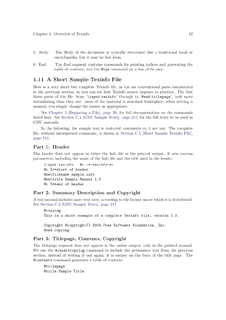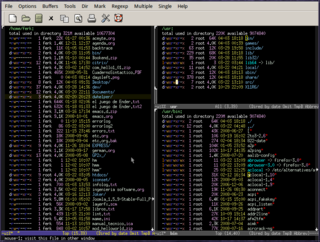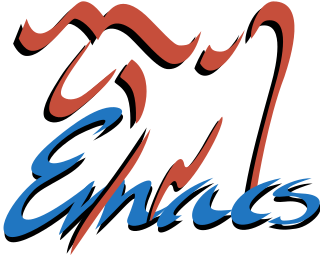Zmacs is one of the many variants of the Emacs text editor. Zmacs was written for the MIT Lisp machine and runs on its descendants (Symbolics Genera, LMI Lambda, TI Explorer). Zmacs is written in Lisp Machine Lisp (called ZetaLisp on Symbolics Lisp Machines). It is based on the ZWEI programming substrate, which stands for "Zwei Was EINE Initially"; Zwei was a collection of routines which could be used to easily implement other programs, like the Symbolics mail program, Zmail.
A distinctive feature of Zmacs, which can also be found in Hemlock and LispWorks, is that commands look like "M-x Compile Buffer" instead of "M-x compile-buffer" as modern Emacsen, like GNU Emacs, generally format commands.
Zmacs also supports buffers and modes. Zmacs also uses the window system of the Lisp Machine with support for mouse and windows. Zmacs supports unlimited backup of files, since the file system of the Lisp Machine supports file versions. It is not compatible with GNU Emacs and its Emacs Lisp.
Common Lisp (CL) is a dialect of the Lisp programming language, published in ANSI standard document ANSI INCITS 226-1994 (S20018). The Common Lisp HyperSpec, a hyperlinked HTML version, has been derived from the ANSI Common Lisp standard.
The editor war is the rivalry between users of the Emacs and vi text editors. The rivalry has become a lasting part of hacker culture and the free software community.

Emacs Lisp is a dialect of the Lisp programming language used as a scripting language by Emacs. It is used for implementing most of the editing functionality built into Emacs, the remainder being written in C, as is the Lisp interpreter. Emacs Lisp is also termed Elisp, although there is also an older, unrelated Lisp dialect with that name.

An integrated development environment (IDE) is a software application that provides comprehensive facilities to computer programmers for software development. An IDE normally consists of at least a source code editor, build automation tools and a debugger. Some IDEs, such as NetBeans and Eclipse, contain the necessary compiler, interpreter, or both; others, such as SharpDevelop and Lazarus, do not.
Symbolics is a defunct computer manufacturer Symbolics, Inc., and a privately held company that acquired the assets of the former company and continues to sell and maintain the Open Genera Lisp system and the Macsyma computer algebra system.

Genera is a commercial operating system and integrated development environment for Lisp machines developed by Symbolics. It is essentially a fork of an earlier operating system originating on the Massachusetts Institute of Technology (MIT) AI Lab's Lisp machines which Symbolics had used in common with Lisp Machines, Inc. (LMI), and Texas Instruments (TI). Genera is also sold by Symbolics as Open Genera, which runs Genera on computers based on a Digital Equipment Corporation (DEC) Alpha processor using Tru64 UNIX. It is released and licensed as proprietary software.
Bytecode, also termed p-code, is a form of instruction set designed for efficient execution by a software interpreter. Unlike human-readable source code, bytecodes are compact numeric codes, constants, and references that encode the result of compiler parsing and performing semantic analysis of things like type, scope, and nesting depths of program objects.

Texinfo is a typesetting syntax used for generating documentation in both on-line and printed form with a single source file. It is implemented by a computer program released as free software of the same name, created and made available by the GNU Project from the Free Software Foundation.
This article provides basic comparisons for notable text editors. More feature details for text editors are available from the Category of text editor features and from the individual products' articles. This article may not be up-to-date or necessarily all-inclusive.
Hemlock is a free Emacs text editor for most POSIX-compliant Unix systems. It follows the tradition of the Lisp Machine editor ZWEI and the ITS/TOPS-20 implementation of Emacs, but differs from XEmacs or GNU Emacs, the most popular Emacs variants, in that it is written in Common Lisp rather than Emacs Lisp and C—although it borrows features from the later editors. Hemlock was originally written by the CMU Spice project in Spice Lisp for the PERQ computer.
EINE and ZWEI are two discontinued Emacs-like text editors developed by Daniel Weinreb and Mike McMahon for Lisp machines in the 1970s and 1980s.

Dired is a computer program for editing file system directories. It typically runs inside the Emacs text editor as a specialized mode, though standalone versions have been written. Dired was the first file manager, or visual editor of file system information. The first version of Dired was written as a stand-alone program independently in 1972 by Dave Lebling at Project MAC, and circa 1974 by Stan Kugell at the Stanford Artificial Intelligence Laboratory (SAIL). It was incorporated into GNU Emacs from the earliest versions, and re-implemented in C and C++ on other operating systems.

Multics Emacs is an early implementation of the Emacs text editor. It was written in Maclisp by Bernard Greenberg at Honeywell's Cambridge Information Systems Lab in 1978, as a successor to the original 1976 TECO implementation of Emacs and a precursor of later GNU Emacs.

MIT/GNU Scheme is a programming language, a dialect and implementation of the language Scheme, which is a dialect of Lisp. It can produce native binary files for the x86 processor architecture. It supports the R7RS-small standard. It is free and open-source software released under a GNU General Public License (GPL). It was first released by the developers at the Massachusetts Institute of Technology (MIT), in 1986, as free software even before the Free Software Foundation, GNU, and the GPL existed. It is now part of the GNU Project.
Daniel L. Weinreb was an American computer scientist and programmer, with significant work in the environment of the programming language Lisp.
Bernard S. Greenberg is a programmer and computer scientist, known for his work on Multics and the Lisp machine.

GNU Emacs is a free software text editor. It was created by GNU Project founder Richard Stallman. In common with other varieties of Emacs, GNU Emacs is extensible using a Turing complete programming language. GNU Emacs has been called "the most powerful text editor available today". With proper support from the underlying system, GNU Emacs is able to display files in multiple character sets, and has been able to simultaneously display most human languages since at least 1999. Throughout its history, GNU Emacs has been a central component of the GNU project, and a flagship of the free software movement. GNU Emacs is sometimes abbreviated as GNUMACS, especially to differentiate it from other EMACS variants. The tag line for GNU Emacs is "the extensible self-documenting text editor".

Emacs or EMACS is a family of text editors that are characterized by their extensibility. The manual for the most widely used variant, GNU Emacs, describes it as "the extensible, customizable, self-documenting, real-time display editor". Development of the first Emacs began in the mid-1970s, and work on its direct descendant, GNU Emacs, continues actively as of 2021.

Emacs Web Wowser is a web browser written entirely in Emacs Lisp. It became part of GNU Emacs starting with version 24.4. If Emacs is compiled with the suitable image libraries, and is used in a graphical environment, it can render images inline directly into Emacs's display buffer. It requires an Emacs built with libxml2 support. Written by Lars Magne Ingebrigtsen, it was originally developed as part of the Emacs mail reader Gnus, to display HTML-formatted email, but with the addition of HTTP support from Emacs' url.el package it became a fully-fledged browser.










